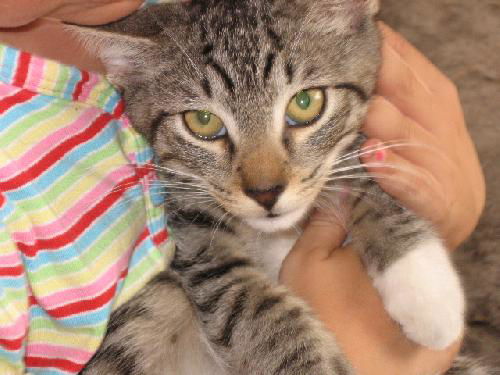Welcome to Pet Rescue By Judy!
401 South Laurel Avenue
Sanford, FL 32771
(407) 302-4497
info@petrescuebyjudy.com
Toronto's Web Page

| My Rescue |
| Login to Remember your Favorite Animals and Breeds! |
Toronto needs a caretaker or foster!
Won't you consider helping him get a new start?
Won't you consider helping him get a new start?
Name: Toronto
Status: Adopted!
Adoption Fee: $150
Species: Cat
Breed: Domestic Short Hair (short coat)
Color: Gray Tabby
Sex: Male
Current Size: 3 Pounds
Potential Size: 9 Pounds
General Potential Size: Medium
Current Age: 16 Years 2 Months (best estimate)
Activity Level: Highly Active
Indoor or Outdoor: Indoor Only
Good with Dogs: Yes
Good with Cats: Yes
Good with Kids: Yes
Declawed: No
Housetrained: Yes
Microchipped: Yes
Toronto's mother, Montreal the Outgoing Tabby (adopted) can also be seen on our website.
Toronto must be adopted with his sister, Vancouver (adopted).
Toronto must be adopted with his sister, Vancouver (adopted).
Description:
Poor Vancouver and Toronto were found in an abandoned apartment with their mom. How horrible! How could someone just abandon these beautiful cats?!
These kittens were TERRIFIED. One of our fantastic fosters took them home and has watched them slowly come out of their shells. Now they live to play (balls and feathers, please) and have become purr babies.
These two are very bonded, so we would prefer that they be adopted together. There will be a reduced fee for both of these little survivors!
If you already have a cat and adopt a second, how do you introduce them to each other? According to the ASPCA, some cats are very social and enjoy living with other cats, while others prefer to be solitary. If you are integrating a new cat into your home, understand that it will take time. The best advice is to introduce the cats gradually and be patient. It takes most cats about 8 to12 months to develop a friendship with a new cat. Others never become friends, but and will simply mutually avoid each other. Still others continue to fight until your only choice is to re-home one of the cats. If you are dealing with cats who have lived harmoniously with other cats in the past, the odds are probably good that they will adjust. However, it is impossible to predict if any two individual cats will get along. If the resident cat becomes aggressive when he or she sees other cats outside the home, you will probably have a difficult time integrating a new cat. There are no reliable guides for deciding the best matches among cats. We do know that male cats—if they do become friends—tend to spend more time with each other. The individual personalities of the cats are more important than any other factor, including sex, age, or size. Be aware that the more cats you have, the higher the likelihood that you will have conflicts between the cats. When you first bring the new cat home The first impression the new cat makes with the resident cat(s) is critical. If the cats display aggression, this may set the mood for their future relationship. For this reason, it is best to separate the cats initially. The cats should be able to smell and hear, but not see or touch, each other. Each cat should have his or her own food and water bowls, litter box, scratching post, bed, etc. Feed the cats near the door that separates them so they learn that coming together, even though they can’t yet see each other, results in a pleasant experience. Feed extra special treats near the door as well—tuna, salmon, cheese, chicken, liver, etc. After 2-3 days, “rotate” the cats so that they can investigate each other’s smell. This also allows the new cat to explore a different section of the home. Some behaviorists even suggest rubbing the cats with the same towel to intermix their scents. After a few more days, play with the cats near the door. In particular, encourage the cats to paw at a toy under the door. Eventually the cats may play “paws” under the door with each other. After a week or so, assuming you see no signs of aggression at the door (no hissing, growling, etc.), replace the door with a temporary screen door so the cats are able to see each other. Continue to encourage feeding, eating treats, and playing near the door. Start these activities a few feet away from the door and, over a few days, gradually move closer. Together at last The next stage is to permit the cats to spend time together. Carefully supervise these interactions. It is good to bring the cats together when they are likely to be relatively calm, such as after a meal or a strenuous play session. Keep a squirt bottle handy in case the cats begin to fight. As the cats become more familiar with each other, allow for longer periods of time together. If one cat spends most of his time hiding, or if one cat is continually harassing and pursuing the other, you should seek the assistance of a certified animal behaviorist or veterinary behaviorist. Be sure to consider the layout of your home. Make sure there are plenty of hiding spots for your cats. Some cats like to sit up high, on shelves and on kitty condo perches. Frightened cats tend to hide under and behind things, so make sure there are hiding places at floor level as well. Place food, water, and litter boxes out in the open so the cats do not feel trapped when accessing these resources. Make sure you have a litter box for each cat and at least one extra.
These kittens were TERRIFIED. One of our fantastic fosters took them home and has watched them slowly come out of their shells. Now they live to play (balls and feathers, please) and have become purr babies.
These two are very bonded, so we would prefer that they be adopted together. There will be a reduced fee for both of these little survivors!
If you already have a cat and adopt a second, how do you introduce them to each other? According to the ASPCA, some cats are very social and enjoy living with other cats, while others prefer to be solitary. If you are integrating a new cat into your home, understand that it will take time. The best advice is to introduce the cats gradually and be patient. It takes most cats about 8 to12 months to develop a friendship with a new cat. Others never become friends, but and will simply mutually avoid each other. Still others continue to fight until your only choice is to re-home one of the cats. If you are dealing with cats who have lived harmoniously with other cats in the past, the odds are probably good that they will adjust. However, it is impossible to predict if any two individual cats will get along. If the resident cat becomes aggressive when he or she sees other cats outside the home, you will probably have a difficult time integrating a new cat. There are no reliable guides for deciding the best matches among cats. We do know that male cats—if they do become friends—tend to spend more time with each other. The individual personalities of the cats are more important than any other factor, including sex, age, or size. Be aware that the more cats you have, the higher the likelihood that you will have conflicts between the cats. When you first bring the new cat home The first impression the new cat makes with the resident cat(s) is critical. If the cats display aggression, this may set the mood for their future relationship. For this reason, it is best to separate the cats initially. The cats should be able to smell and hear, but not see or touch, each other. Each cat should have his or her own food and water bowls, litter box, scratching post, bed, etc. Feed the cats near the door that separates them so they learn that coming together, even though they can’t yet see each other, results in a pleasant experience. Feed extra special treats near the door as well—tuna, salmon, cheese, chicken, liver, etc. After 2-3 days, “rotate” the cats so that they can investigate each other’s smell. This also allows the new cat to explore a different section of the home. Some behaviorists even suggest rubbing the cats with the same towel to intermix their scents. After a few more days, play with the cats near the door. In particular, encourage the cats to paw at a toy under the door. Eventually the cats may play “paws” under the door with each other. After a week or so, assuming you see no signs of aggression at the door (no hissing, growling, etc.), replace the door with a temporary screen door so the cats are able to see each other. Continue to encourage feeding, eating treats, and playing near the door. Start these activities a few feet away from the door and, over a few days, gradually move closer. Together at last The next stage is to permit the cats to spend time together. Carefully supervise these interactions. It is good to bring the cats together when they are likely to be relatively calm, such as after a meal or a strenuous play session. Keep a squirt bottle handy in case the cats begin to fight. As the cats become more familiar with each other, allow for longer periods of time together. If one cat spends most of his time hiding, or if one cat is continually harassing and pursuing the other, you should seek the assistance of a certified animal behaviorist or veterinary behaviorist. Be sure to consider the layout of your home. Make sure there are plenty of hiding spots for your cats. Some cats like to sit up high, on shelves and on kitty condo perches. Frightened cats tend to hide under and behind things, so make sure there are hiding places at floor level as well. Place food, water, and litter boxes out in the open so the cats do not feel trapped when accessing these resources. Make sure you have a litter box for each cat and at least one extra.
Other Pictures of Toronto (click to see larger version):
 46.4k |
 413.4k |
 42.5k |
Copyright © Pet Rescue by Judy





